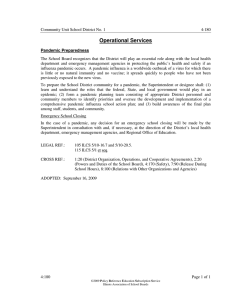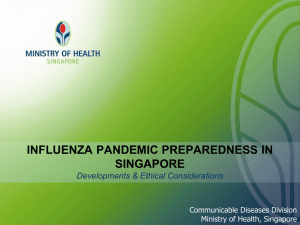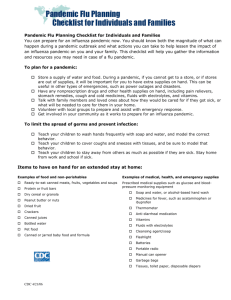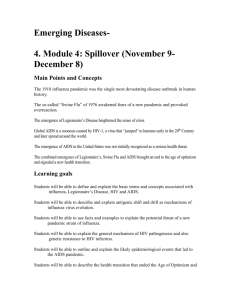How the UK will respond
advertisement
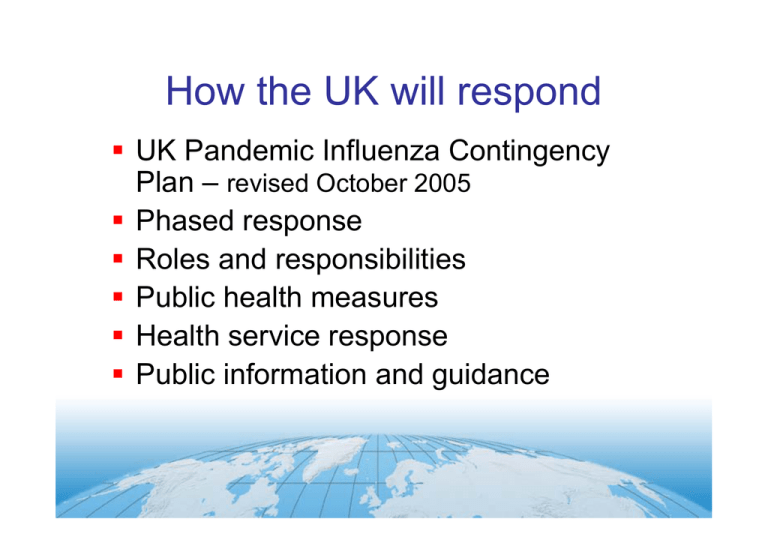
How the UK will respond UK Pandemic Influenza Contingency Plan – revised October 2005 Phased response Roles and responsibilities Public health measures Health service response Public information and guidance Role of DH Providing overall leadership Leading the public health response Leading the health service response Providing others with the information they need for their own part of the response The UK Pandemic Influenza Contingency Plan: Key Objectives Strong surveillance and alert system Containing infection to reduce illness and deaths Treating the ill Ensuring the continuation of essential services to minimise social and economic disruption Ensuring that the public, health professionals and media have up-to-date, comprehensive information Support from the centre DH will provide: Operational planning advice Advice on delivering the national antiviral strategy locally Clinical management guidelines - with patient treatment algorithms Infection control guidelines Guidance on mass vaccination Phases of the response Phased approach (WHO Classification) Interpandemic period: actions required before a pandemic is announced Pandemic alert period: escalation of preparedness plans Pandemic period: actions required once a pandemic is announced Post pandemic period: actions required when the pandemic is over WHO Alert Phases INTERPANDEMIC PERIOD Phase 1: No new influenza virus subtypes have been detected in humans. An influenza virus subtype that has caused human infection may be present in animals. If present in animals, the risk a of human infection or disease is considered to be low Phase 2: No new influenza virus subtypes have been detected in humans. However, a circulating animal influenza virus subtype poses a substantial risk a of human disease WHO Alert Phases PANDEMIC ALERT PERIOD WHERE WE ARE NOW Phase 3: Human infection(s) with a new subtype, but no human-to-human spread, or at most rare instances of spread to a close contact WHO Alert Phases PANDEMIC ALERT PERIOD Phase 4: Small cluster(s) with limited human-to-human transmission but spread is highly localised, suggesting that the virus is not well adapted to humans Phase 5: Larger cluster(s) but human-tohuman spread still localised, suggesting that the virus is becoming increasingly better adapted to humans, but may not yet be fully transmissible (substantial pandemic risk) WHO Alert Phases PANDEMIC PERIOD Phase 6: Increased and sustained transmission in general population Five UK alert levels Alert level 0 1 2 3 4 No cases anywhere in the world Cases only outside the UK New virus isolated in the UK Outbreak(s) in the UK Widespread activity across the UK Resources available www.dh.gov.uk/pandemicflu Infection management and control Clinical management guidance and infection control guidance coming soon Summary Pandemic flu is different from ‘ordinary’ seasonal flu – more people will become ill, more will die Specific vaccine cannot be prepared ahead of the pandemic; actions are taking place to speed vaccine production as soon as the pandemic virus is identified Global surveillance is essential; international co-operation is well established Summary (cont) Antiviral drugs are being stockpiled; when a pandemic arrives they may help slow its progress and reduce severity of illness Social measures (for example basic hygiene or limiting some population movement) may help slow a pandemic Advance planning by Government, the NHS, essential services and local communities will help to reduce the impact More information can be found at: www.dh.gov.uk/pandemicflu www.hpa.org.uk
